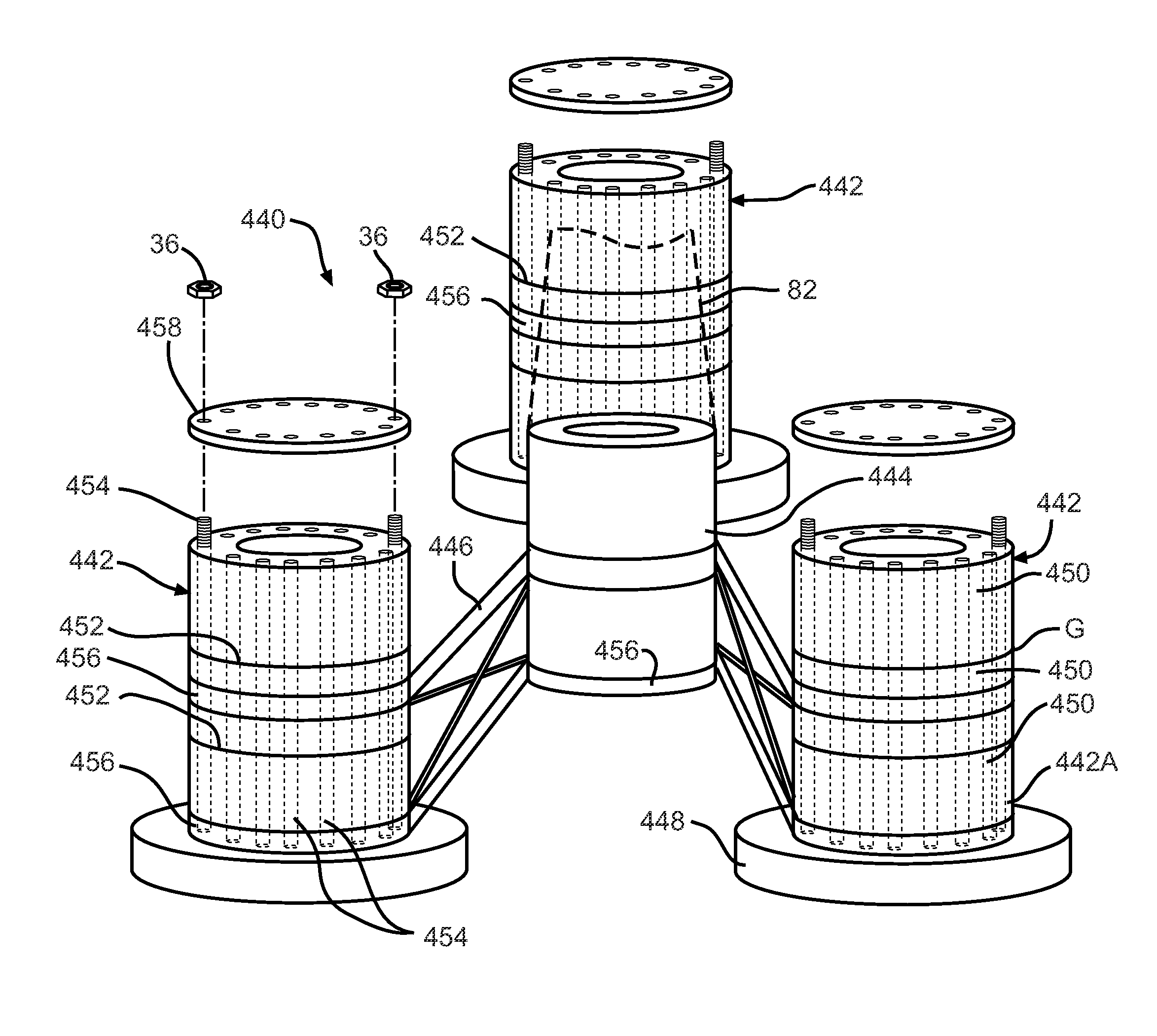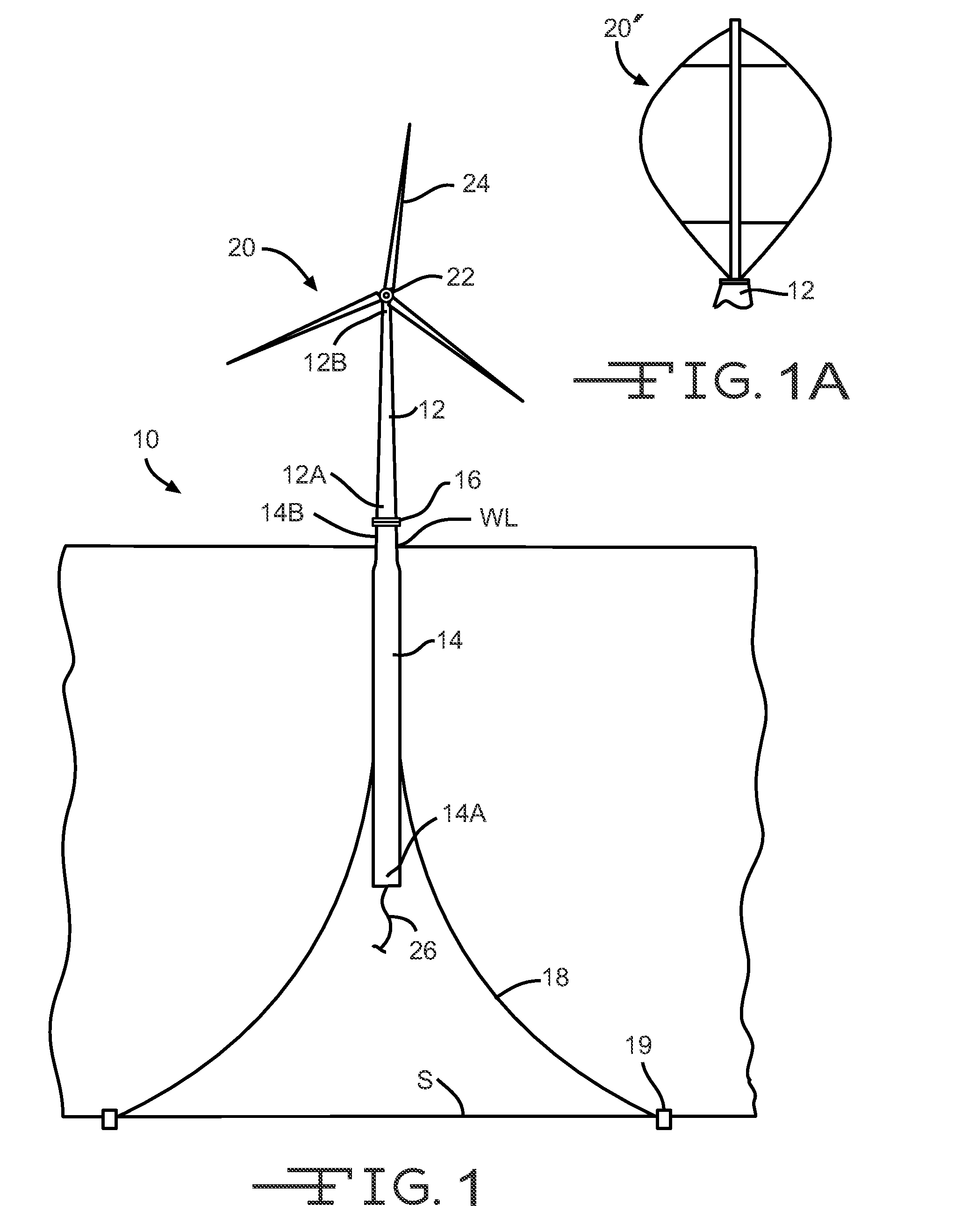Floating hybrid composite wind turbine platform and tower system
a wind turbine platform and hybrid technology, applied in the field of floating wind turbine platforms, can solve the problems of unsatisfactory aesthetics, unsatisfactory wind turbines, and inability to achieve the optimal flow of air on land
- Summary
- Abstract
- Description
- Claims
- Application Information
AI Technical Summary
Problems solved by technology
Method used
Image
Examples
first embodiment
[0050]Referring to the drawings, particularly to FIG. 1, a floating composite wind turbine platform 10 is shown anchored to the seabed S. The illustrated floating wind turbine platform 10 is a ballast stabilized, spar buoy type platform and includes a tower 12 attached to a hull 14 at a connection joint 16. Mooring lines 18 are attached to the hull 14 and further anchored to the seabed S by anchors 19. A wind turbine 20 is mounted to the tower 12.
[0051]A spar buoy type platform maintains its stability afloat by keeping its center of gravity below its center of buoyancy. This relationship of the center of gravity being below the center of buoyancy is often achieved by filling a heavy long tube or hull with ballast comprising water and dense material such as rocks.
[0052]In the embodiments illustrated herein, the wind turbine 20 is a horizontal-axis wind turbine. Alternatively, the wind turbine may be a vertical-axis wind turbine, such as shown at 20′ in FIG. 1A. The size of the turbin...
second embodiment
[0067]Referring to FIG. 19, a floating composite wind turbine platform is shown at 10′. The illustrated floating wind turbine platform 10′ is substantially similar to the floating composite wind turbine platform is shown at 10, but the tower 12 and the hull 14 are formed as a one-piece tower / hull member 11. In this embodiment, the connection joint 16 is not required. The one-piece tower / hull member 11 may be formed from FRP composite in the same manner as the tower 12, described in detail above. Alternatively, the one-piece tower / hull member 11 may be formed from may be formed from reinforced concrete in the same manner as the hull 14, described in detail above.
[0068]The interior of the tower / hull member 11 defines an elongated cavity 17 within the tower / hull member 11. In the illustrated embodiment, a wall 38 extends transversely within the cavity 17 and divides the cavity 17 into a tower cavity portion 13′ and a hull cavity portion 15′. At least a portion of the tower cavity porti...
third embodiment
[0097]Referring now to FIG. 11, a floating composite wind turbine platform 60 is shown anchored to the seabed S. The illustrated floating wind turbine platform 60 is similar to the mooring line stabilized, tension leg type platform 40 illustrated in FIG. 8 and includes a tower 62 attached to the hull platform 44 at a connection joint 66. Mooring lines 48 are attached to the hull platform 44 and further anchored via anchors 19 to the seabed S. The wind turbine 20 is mounted to the tower 62. Cable stays 64 are attached to the hull platform 44 and further attached to the tower 62.
[0098]In the illustrated embodiment, the tower 62 is formed as a tube and is fabricated from fiber reinforced polymer (FRP) composite material. Non-limiting examples of suitable FRP composite material include glass and carbon FRP. Alternatively, the tower 62 may be formed from concrete or from steel, as described above.
[0099]Because the cable stays 64 reduce bending stress in the tower 62, the tower 62 can be ...
PUM
| Property | Measurement | Unit |
|---|---|---|
| depth | aaaaa | aaaaa |
| depths | aaaaa | aaaaa |
| depths | aaaaa | aaaaa |
Abstract
Description
Claims
Application Information
 Login to view more
Login to view more - R&D Engineer
- R&D Manager
- IP Professional
- Industry Leading Data Capabilities
- Powerful AI technology
- Patent DNA Extraction
Browse by: Latest US Patents, China's latest patents, Technical Efficacy Thesaurus, Application Domain, Technology Topic.
© 2024 PatSnap. All rights reserved.Legal|Privacy policy|Modern Slavery Act Transparency Statement|Sitemap



